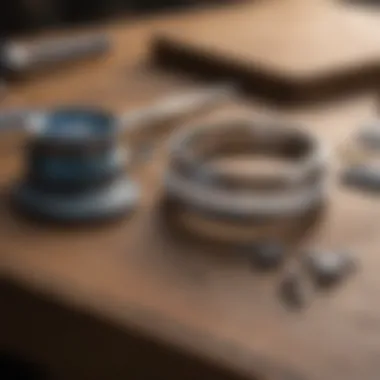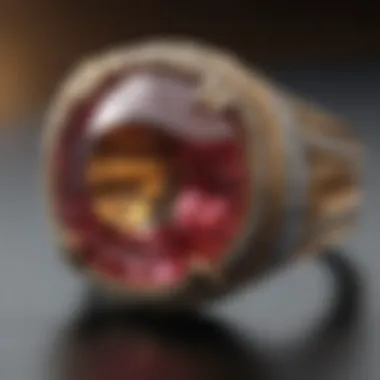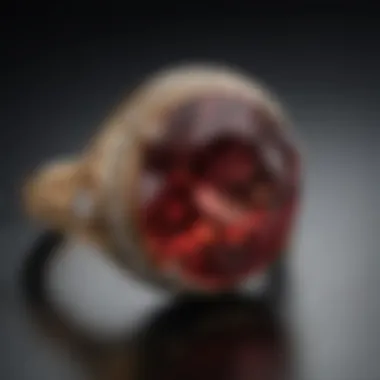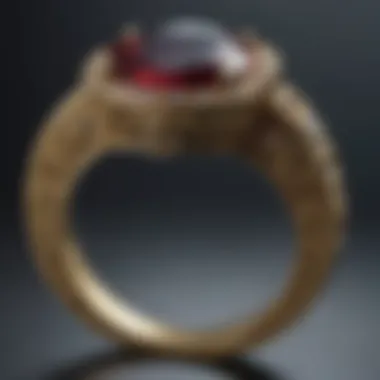Mastering Ring Sizes: A Comprehensive Guide


Intro
Determining the correct size for a ring is an essential aspect of jewelry purchasing. A ring that fits well not only enhances its aesthetic appeal but also ensures comfort during wear. As people seek rings for various reasons, understanding how to size them effectively becomes a key consideration. This guide aims to provide a structured approach to ring sizing, making the process accessible and informative. Readers will explore different methods of measurement, delve into various international sizing systems, and learn how to avoid common mistakes.
Measuring Ring Size
Basic Methods of Measuring
The first step in finding a ring's size is taking accurate measurements. There are a few straightforward methods to determine this:
- Using a Ring Sizer: This tool, often available at jewelry stores, consists of a set of rings in different sizes. You can try on various rings until you find a comfortable fit.
- Measuring with a String or Strip of Paper: Wrap a piece of string around the base of the finger where the ring will sit. Make sure it is snug but not too tight. Mark the point where the string overlaps and measure this length with a ruler.
- Using a Current Ring: If you have a ring that fits well, you can determine its size by measuring its inner diameter with a caliper or a ruler. Compare this measurement to a ring size chart to find the corresponding sizes.
International Sizing Systems
Ring sizes vary from one country to another, which can lead to confusion for buyers. Here are the main international sizing systems:
- US and Canada: These sizes generally range from size 3 to 13, with half sizes available.
- UK and Australia: This system uses letters from A to Z, with half sizes denoted by a decimal (e.g., K½).
- Europe: Ring sizes in Europe are measured in millimeters, correlating to the inner circumference of the ring.
Understanding these variations is crucial when purchasing rings online from international sellers or ensuring that custom jewelry fits appropriately.
Importance of Accurate Sizing
Obtaining the correct ring size is vital for several reasons. It can prevent discomfort that comes from a tight or loose fit. Moreover, accurate sizing can help maintain the integrity of the ring, protecting precious gemstones or materials from being damaged due to improper fitting.
"A well-fitted ring is not only more comfortable to wear, but it also showcases the craftsmanship and design of the piece more effectively."
Common Mistakes in Ring Sizing
Here are some mistakes individuals often make when determining ring size:
- Measuring at the Wrong Time: Fingers can swell throughout the day, especially in hot weather. It's best to measure finger size in the evening for the most accurate results.
- Assuming Size: Guessing a size based on clothing size or age can lead to inappropriate sizing.
- Ignoring Ring Width: Wider bands may require a larger size for comfort.
Tips for Correct Sizing
- Consult a Professional: When in doubt, visiting a jeweler can provide the most accurate sizing.
- Take Multiple Measurements: Always take several measurements using different methods to ensure accuracy.
- Use a Ring Size Chart: Having a printed ring size chart handy can aid in quick conversions between systems.
Culmination
Understanding how to determine the correct ring size involves a blend of measuring techniques and an appreciation of international standards. By taking time to measure accurately and avoid common pitfalls, you can ensure both comfort and style in your jewelry purchase. This guide provides a pathway to make the process straightforward, encouraging individuals to educate themselves on the nuances of jewelry sizing.
For additional information about ring sizing, you can visit Wikipedia or Britannica.
Other resources include forums like Reddit for community insights and discussions.
Understanding Ring Size
Understanding ring size is fundamental for anyone involved in purchasing, designing, or even wearing rings. Many factors contribute to the overall experience of wearing a ring, from comfort to aesthetics. An ill-fitting ring can lead to discomfort, loss, or even damage to the ring itself. Therefore, grasping the nuances of ring sizing is crucial.
Definition of Ring Size
Ring size refers to the measurement that determines how well a ring fits on a finger. This measurement can differ by country and can be influenced by the shape and width of the band. The size is typically expressed as a number, but in some regions, it may be presented with letters or a combination thereof. The accuracy of determining the right ring size is paramount as it directly affects the wearer's comfort.


Importance of Accurate Sizing
Accurate sizing is more than just a practical consideration; it embodies the wearer’s attachment to their ring. When a ring fits correctly, it maintains its position without slipping or pinching. A snug fit ensures the ring remains securely on the finger, while also allowing for slight changes in temperature and finger size throughout the day.
Moreover, a well-sized ring contributes to the aesthetics of the piece. It allows for the proper display of intricate designs and gemstones. An inaccurately sized ring does not only present a risk of physical discomfort but can also detract from the visual appeal.
"Rings are often seen as symbols of commitment and affection. Their value increases when they fit well, as they represent more than just jewelry."
Consequently, grasping the concept of ring size lays the groundwork for informed choices, whether for personal use or as a gift. Understanding how to measure and what different sizing systems mean greatly enhances the experience of purchasing or crafting jewelry.
Methods to Measure Ring Size
Determining the correct ring size is essential for comfort and aesthetic appeal. An ill-fitting ring can cause discomfort or even loss of the ring itself. Understanding different methods for measuring ring size can help ensure that the correct size is identified, thus preventing the need for costly resizing or replacement. This section will outline practical techniques and considerations that can facilitate accurate ring sizing, providing a comprehensive guide to selecting the optimal size.
Using a Ring Sizer
Using a ring sizer is one of the most effective methods to obtain an accurate size. A ring sizer is typically a set of plastic or metal rings of various sizes, available in jeweler stores or online. This method provides a physical representation of different sizes, which can help individuals understand their precise fitting. When using a ring sizer, it is important to ensure that the ring fits comfortably over the knuckle and allows for a slight adjustment for swelling or temperature changes.
Measuring a Current Ring
Another straightforward approach is to measure a current ring. If an accurate size is needed, find a ring that fits well on the intended finger. Using a ruler or a specialized measuring device, one can measure the inner diameter of the ring in millimeters. This measurement can then be compared to a ring size chart for conversion. While this method is practical, it's beneficial to verify the fitting on the same finger intended for the new ring, as sizes can vary depending on finger placement.
Using String or Paper Strip
In situations where a ring sizer or existing ring is not available, using a string or paper strip may serve as a suitable alternative. Take a piece of paper or thread and wrap it around the base of the finger. Mark the point where the two ends meet, and then measure the length with a ruler. Similar to measuring a current ring, this length can be converted into size using a standard size chart. One should also consider any variations, such as finger swelling, that may affect the measurement.
Professional Sizing Services
For those seeking precision, utilising professional sizing services offered by a jeweler is a recommended option. Jewelers possess specialized tools and expertise to determine the correct size accurately. They can also account for specific characteristics like finger shape and swelling that influence size. Additionally, visiting a jeweler can facilitate discussions regarding the desired ring design, helping to correlate aesthetics with functionality without compromise.
Professional sizing can provide valuable insight and ensure the perfect fit, considering elements hard to measure at home.
Each of these methods serves different needs and situations. Ultimately, selecting the most appropriate method depends on availability and the individual’s comfort with the process. Regardless of the method chosen, accurate measurements are an indispensable part of ensuring that a ring fits appropriately.
Understanding Sizing Systems
Understanding the various ring sizing systems is crucial for making informed decisions when purchasing or custom-designing rings. Different regions employ different sizing methodologies. Without this knowledge, individuals risk poor fit, discomfort, and even dissatisfaction. Gemstone enthusiasts, collectors, and jewelry designers must navigate these systems to find the correct size that complements their design or collection.
The significance of understanding sizing systems extends beyond mere numbers. It encompasses cultural differences in measurement and the potential consequences of miscommunication between buyers and jewelers. Familiarity with sizing systems can save time, bring clarity to a purchase, and ensure that the final product meets expectations.
United States Sizing
In the United States, ring sizes are represented by numerical values, commonly ranging from 3 to 13 for women and 6 to 16 for men. This system is based on the circumference of the ring in millimeters. For example, a size 7 ring typically has an inner diameter of about 17.3 millimeters.
It is important to note that half sizes and quarter sizes are also available, providing further customization. A size 7.5 or 7.25 gives more precise fitting options. This flexibility is essential for ensuring comfort.
European Sizing
European sizing operates on a different scale, utilizing measurements based on the internal circumference of the ring in millimeters. Sizes range from approximately 44 to 70. For example, a size 54 equates to a circumference of 54 millimeters.
One key consideration is that there are no half sizes in the European system. As a result, purchasing requires more caution, as a size may fit more snugly or loosely than expected. Conversions to and from US sizes can help bridge the gap but still require careful attention to detail.
UK and Australian Sizing


The UK and Australian systems use an alphabetical sizing method. Typically, sizes range from A to Z and include half sizes as well. For instance, a size K ring corresponds to a size 6 in the US size chart.
While this method may seem straightforward, it can be confusing for those unfamiliar with the system. Knowledge of conversions aids in understanding how one size relates to another, therefore facilitating a satisfactory purchase.
Asian Sizing Systems
Asian sizing, particularly popular in countries like Japan and China, employs a numerical system similar to the US, but with variations in measurements. For instance, a Japanese size 13 often signifies an inner diameter of about 13 millimeters, which differs from standard US measures.
Due to these differences, individuals must take care to research the specific chart used by local jewelers or retailers. Familiarizing oneself with these conversions can enhance the shopping experience and support better fitting outcomes.
"Navigating ring sizing systems is less about knowing numbers and more about understanding your needs and preferences for comfort, design, and personal style."
The understanding of these sizing systems is imperative for gemstone enthusiasts and collectors. Tailoring the fit to individual specifications increases satisfaction and nurtures a deeper connection to the jewelry. Ensuring that proper sizing is prioritized can lead to successful purchases, enhancing the overall experience in the world of rings.
Common Issues in Ring Sizing
Understanding the common issues that can arise in ring sizing is essential for anyone looking to purchase a ring. Accurately determining the ring size is not merely a matter of convenience; it directly influences comfort and the overall satisfaction with a piece of jewelry. Failing to consider these issues can lead to a poor fit, causing discomfort or even the loss of the ring.
Mistaking Size Variations
Many people underestimate the importance of consistent measurement techniques. Variations in ring size can arise due to different methods of sizing. It is crucial to recognize that not all rings are created equal. For instance, a narrow band may fit differently than a wider one. Furthermore, different manufacturers may have their own sizing standards. When determining size, it is vital to compare measurements across various brands to ensure consistency and accuracy. Misunderstanding these variations can result in purchasing a ring that does not fit as expected. The best practice is to try rings made by the same brand or at least verify sizing through recognized charts.
Temperature Effects on Size
Temperature can play an unexpected role in ring sizing. Metal expands and contracts with changes in temperature. This means that a ring might fit perfectly during warm weather, but feel tight or loose in cooler environments. Understanding this phenomenon can save you from the discomfort of an incorrectly sized ring based only on how it feels during a particular season. If you are measuring your finger for a ring, consider doing so at room temperature. It is advisable to avoid measuring in very hot or cold conditions to ensure a more reliable result.
Finger Swelling and Size Changes
Finger size is not static. It naturally varies throughout the day due to several factors including physical activity, hydration levels, and even diet. For example, fingers tend to swell during hot weather or after exercising. Moreover, certain medical conditions can lead to significant changes in finger size. This variability must be taken into account, as it can alter how a ring feels. To achieve the most accurate size, measure your finger at different times of the day and under similar conditions; for instance, at the end of the day when your fingers may be swelled slightly.
To ensure the best fit, remember to factor in natural fluctuations in the size of your fingers due to temperature changes and daily activities.
By being aware of these common issues in ring sizing, individuals can make more informed choices when selecting rings, enhancing both wearability and satisfaction.
Adjusting Ring Size
Adjusting the size of a ring is a critical consideration for anyone who desires a proper fit. Wearing a size that suits your finger is not only about comfort but also about aesthetics. A well-fitted ring enhances the beauty of the design and prevents frustration. Rings that are too tight can cause discomfort and potential damage to the jewelry, while those that are too loose can easily slip off and be lost.
The significance of adjusting ring size extends into several areas. Firstly, health considerations should be acknowledged. For instance, as a person's weight fluctuates, so can their finger size. Moreover, temperature can also influence how snugly a ring fits, a factor often overlooked. Thus, being aware of one’s ring size and being able to adjust it is vital for overall enjoyment of wearing the piece.
When considering adjustments, both professional and DIY options exist. Each method has its strengths and considerations that should be understood. Making an informed choice ensures that one's ring remains not only stylish but functional as well.
Professional Resizing
Professional resizing is the most reliable method for adjusting a ring size. Jewelers have the necessary tools and expertise to safely resize a ring without compromising its integrity. They can increase or decrease the size accurately, ensuring a perfect fit. This process typically involves either adding or removing material from the band.
When opting for professional resizing, it is crucial to select a reputable jeweler. Their experience will dictate how well they handle specific metal types and designs. Some metals, like platinum, require specialized techniques for resizing. Furthermore, intricate designs or rings with gemstones may also dictate different resizing processes. Here are some aspects to consider:
- Cost: Professional resizing can be more expensive than DIY methods. However, this cost is justified by the quality of the work.
- Time: The process might require several days, depending on the jeweler's workload.
- Skill: Professionals can anticipate potential issues that DIY methods might overlook.
Do-It-Yourself Methods
For those who prefer a hands-on approach, there are several do-it-yourself methods for adjusting ring size. While they might not provide the precision of professional resizing, they are often practical solutions for temporary adjustments. Here are a few popular methods:


- Sizing beads: These are small metal balls that can be inserted inside the band of a ring to make it fit tighter. It’s a quick fix that is easily reversible.
- Ring adjusters: These are clear silicone or rubber inserts that can be placed on the underside of the ring. They are discreet and can stretch or contract according to finger size fluctuations.
- Wire wrapping: A more creative approach involves wrapping wire around the band to make it snugger. Although it changes the original design, it can be an artistic solution for temporary needs.
Keep in mind that DIY methods lack the durability of professional resizing. They are best used for immediate fixes rather than permanent solutions.
"Understanding ring sizing is essential for jewelry lovers to enjoy their pieces fully. A proper fit contributes to both comfort and elegance."
Ultimately, the choice between professional and DIY methods for adjusting ring size will depend on individual circumstances—considering factors like urgency, the importance of the piece, and personal skill level.
Custom Rings: Considerations
When contemplating the purchase of a custom ring, several factors should be taken into account to ensure the final product meets your expectations. Custom rings offer unique options for personal expression and style. However, these benefits come with their own set of challenges, particularly regarding accurate sizing. Proper sizing is crucial. A poorly sized custom ring can lead to discomfort or misalignment and can affect the visual appeal of the design.
One of the essential elements of a custom ring is the initial consultation with a jeweler. This step will help you understand the various aspects involved in creating your ring. It also establishes a clear communication line with your jeweler, ensuring that your vision aligns with their expertise.
Importance of Initial Sizing Consultation
The importance of an initial sizing consultation cannot be overstated. During this meeting, the jeweler will assess your finger size accurately. This involves various measurement techniques, which could include using a ring sizer or a mandrel. The jeweler will take the time to understand your preferences, including the style of the ring, the type of metal, and any gemstones you wish to incorporate.
Moreover, the consultation allows you to discuss any concerns or special requests. For instance, if you have fluctuating finger sizes due to climate or health conditions, sharing this information will enable the jeweler to make appropriate adjustments or recommendations.
Accurate sizing is foundational when designing custom jewelry. A small mistake can result in significant discomfort.
A skilled jeweler will guide you through the sizing options and may suggest ways to prepare for changes over time, such as using a wider band for comfort or utilizing specific materials that adjust better to different sizes. The professional insight provided in this initial stage is invaluable for ensuring that the final piece is both aesthetically pleasing and comfortable.
Choosing the Right Jeweler
Choosing the right jeweler can make a substantial difference in the experience of acquiring a custom ring. A qualified jeweler will not only have skills in craftsmanship but will also understand the nuances involved in ring sizing and design.
Consider the following factors when selecting a jeweler:
- Experience and Expertise: Look for jewelers who specialize in custom designs. Their portfolio should reflect notable craftsmanship and creativity.
- Customer Reviews: Read reviews or testimonials from previous clients. This feedback will provide insight into their satisfaction levels and any common issues faced during the process.
- Communication Skills: A jeweler who communicates clearly and frequently can help mitigate misunderstandings and ensure your vision is realized.
- Consultation Services: Opt for jewelers who encourage initial consultations. This is vital for accurately identifying your needs and preferences.
Ultimately, the choice of jeweler will influence not just the ring's final appearance but also the overall satisfaction with the process. Taking time to select the right professional can lead to a beautifully crafted, perfectly sized custom ring that meets your expectations.
Epilogue
In the journey of selecting the right ring size, it is essential to understand its significance. Ring sizing goes beyond mere convenience; it directly impacts the wearer's comfort and overall satisfaction. An accurately sized ring not only enhances the beauty of the piece but also ensures it remains secure and easy to wear in daily life.
Recap of Key Points
The article discussed several crucial aspects regarding ring sizing. Firstly, we explored various methods to measure ring size, such as using a dedicated ring sizer, measuring current rings, or even simple techniques like string and paper strips. Each of these methods offers a unique approach and can be used based on the tools available.
Understanding the different sizing systems used worldwide is also vital. The United States, Europe, the UK, and Asia each have their quirks, which can lead to confusion when buying international jewelry. Familiarity with these systems saves time and potential embarrassment at the jeweler's.
We pointed out common issues that can distort proper sizing, such as temperature fluctuations, temporary finger swelling, and unintentional size variations. Overlooking these factors can result in an ill-fitting ring, rendering the entire process ineffective.
Additionally, we discussed the implications of custom rings. Seeking a reputable jeweler for initial sizing consultations is crucial, as they can guide what size may be best suited for a personalized piece.
Encouragement for Accurate Measurements
Achieving the correct ring size is not just about immediate preferences. It reflects on the quality and enjoyment of the jewelry. Taking a few extra moments to ensure accuracy can lead to years of comfortable and joyful wear.
Those engaging in jewelry consultations should actively ask questions and utilize provided tools; this proactive approach greatly reduces the risk of sizing errors. It is always advisable to measure multiple times or in various conditions to ensure accuracy.
Furthermore, be mindful. If unsure, do not hesitate to consult with professionals who can offer clarity and precision. Remember, an accurate measurement is the foundation of satisfaction with any ring, whether it’s an engagement ring or an everyday accessory.
"A perfect-fitting ring symbolizes not just love, but also precision in understanding one’s needs and preferences."
By taking these considerations into account, readers can confidently navigate the intricacies of ring sizing and enjoy their jewelry collection to the fullest.



